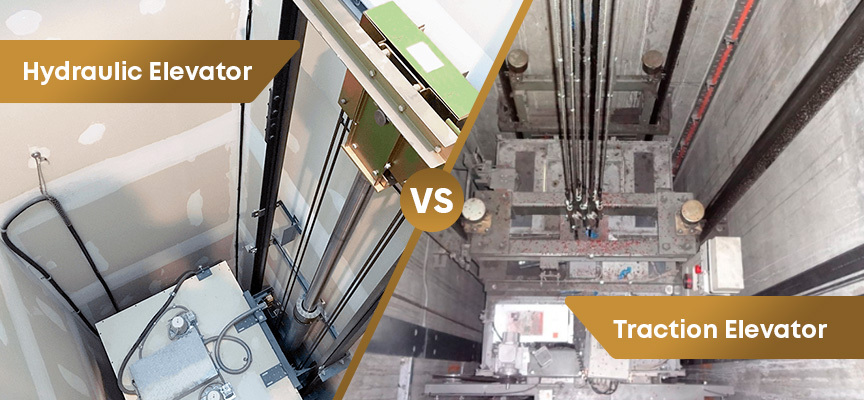
Many Canadian homeowners are now looking to improve accessibility and prepare their homes for the future. Because of this, residential elevators are no longer seen as luxury additions. They’ve become practical necessities.
Home elevators can help people age in place, improve mobility, and increase the value of multi-level homes but installing one is a major decision. Among the available options, hydraulic and traction elevators are the two most common choices for homes.
Understanding the differences between these systems is essential. It helps ensure your decision fits your home’s layout, your budget, and your long-term goals.
This detailed blog breaks down the mechanics, benefits, limitations, and ideal uses of both elevator types. By the end, you’ll have the clarity you need to choose the right system for your home and lifestyle.
What Are Hydraulic and Traction Elevators
Hydraulic Elevators
Hydraulic elevators operate using a piston mechanism powered by hydraulic fluid. When the fluid is pumped into the cylinder, it pushes the piston, raising the elevator car.
To descend, the fluid is released in a controlled manner, allowing the car to lower smoothly. These systems are typically used in low-rise buildings and are known for their simplicity and cost-effectiveness.
Traction Elevators
Traction elevators utilize steel ropes or belts and a counterweight system. An electric motor drives a sheave (pulley), moving the ropes and consequently, the elevator car. This design is common in mid to high-rise buildings and is favoured for its energy efficiency and smoother ride quality.
Comparing Hydraulic And Traction Elevators
Installation And Space Requirements
- Hydraulic Elevators: Require a machine room and a pit for the piston mechanism. They are generally easier and quicker to install, making them suitable for existing homes where space is limited.
- Traction Elevators: Can be designed as machine-room-less (MRL) systems, saving space. However, they require a taller shaft and more complex structural accommodations, which might be challenging in some residential settings.
Energy Efficiency
- Hydraulic Elevators: Consume more energy during operation, especially when lifting the car. They are less energy-efficient compared to traction systems.
- Traction Elevators: More energy-efficient due to the counterweight system, which balances the load and reduces the motor’s workload. This efficiency translates to lower operating costs over time.
Ride Quality And Speed
- Hydraulic Elevators: Offer a smooth ride but operate at slower speeds, typically suitable for homes with up to five stories.
- Traction Elevators: Provide a faster and quieter ride, making them ideal for taller residential buildings or when speed is a priority.
Maintenance And Longevity
- Hydraulic Elevators: Have fewer moving parts, which can mean lower maintenance costs. However, they may require more frequent servicing due to potential issues like fluid leaks.
- Traction Elevators: Generally have higher initial maintenance costs but benefit from longer lifespans and fewer issues over time, especially with modern MRL designs.
Cost Considerations
- Hydraulic Elevators: Typically have lower upfront installation costs, making them an attractive option for budget-conscious homeowners. However, the long-term operating costs may be higher due to energy consumption and maintenance needs.
- Traction Elevators: Involve a higher initial investment but offer savings over time through energy efficiency and reduced maintenance. They also tend to add more value to the property due to their advanced features and longevity.
Environmental Impact
- Hydraulic Elevators: Use hydraulic fluid, which poses environmental risks if it leaks. Proper maintenance and newer, eco-friendly fluids can mitigate these concerns.
- Traction Elevators: Considered more environmentally friendly due to their energy efficiency and lack of hazardous fluids. They align better with green building practices.
Making The Right Choice for Your Home
When deciding between hydraulic and traction elevators consider the following:
- Home Structure: Evaluate the available space, number of floors, and structural capabilities.
- Budget: Assess both the initial installation costs and long-term operating expenses.
- Usage Needs: Determine the frequency of use, desired speed, and capacity requirements.
- Future Plans: Consider potential home expansions or resale value implications.
Consulting with professional elevator contractors can provide personalized insights and help you navigate building codes and technical specifications.
Who We Are
At Eurobuild Construction, we specialize in delivering high-quality residential and commercial construction services across Vancouver and the Lower Mainland. Our expertise includes custom home builds, renovations, and the installation of advanced elevator systems tailored to your specific needs.
With a commitment to excellence and customer satisfaction, our team of experienced elevator contractors ensures seamless integration of elevators into your home, enhancing accessibility and value.
Contact us today to discuss your elevator installation project and discover how we can help bring your vision to life.

